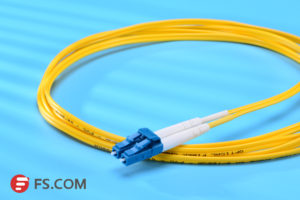With vast demanding of the higher bandwidth and faster speed, the growth of single mode fiber optic cable market has enhanced over the past several years. Maybe there are still a lot of people who do not know what single mode fiber optic cable is and why it can improve the development of the network communication. So the following article will solve all your problems. This article will focus on its definition, types, advantages and disadvantages.
The Definition of Single Mode Fiber Optic Cable
Single mode fiber (SMF), is an optical fiber that is designed for the transmission of a single ray or mode of light as a carrier to propagate at a time. Single mode fiber optic cable core is 8 to 9 micons which is about one-tenth of a human hair. So the core diameter of single mode fiber optic is smaller than multimode fiber optic cable. But it can provide higher transmission speeds and higher information transmission capacity.

Single Mode Fiber Optic Cable Types: OS1 VS OS2
From “Fiber Optic Cable Brings to a New Era of Network,” we can know that fiber optic cable is divided into two kinds—single mode fiber optic cable and multimode fiber optic cable. As we know, multimode fiber optic cable is usually divided into OM1, OM2, OM3, OM4 and OM5 fiber types. And what about single fiber optic cable? According to SMF specifications, single fiber optic cable can be categorised into OS1 and OS2. The main difference between OS1 and OS2 single fiber optic cable is the cable constructions. In general, OS1 cabling is tight-buffered which can be used for indoor applications. On the contrary, OS2 cabling is loose-tube design which can be used for outdoor applications. The maximum transmission distance of OS2 single mode fiber optic cable is up to 10 km but OS1 single mode fiber optic cable can just reach 2km. Both OS1 and OS2 fiber optic cable allow a distance of gigabit to 10G Ethernet. Besides, OS2 fiber can support 40G and 100G Ethernet.
Single Mode Fiber Optic Cable: Advantages and Disadvantages
Advantages
Single mode fiber optic cable is perfect for long distance transmission and has greater bandwidth capacity than multimode fiber optic cable. The use of single mode fiber cable can limit data dispersion and external interference. Single mode fiber cable has fast transmission speed which can support data transmission speed up to 10Gbps, 40Gbps, 100Gbps.
Disadvantages
Due to smaller core diameter, coupling light into the core is more difficult. Besides, compared with multimode fiber optic cable, single mode fiber optic cable costs more.
Conclusion
The use of single mode fiber optic cable realizes signal transmission over long distance. So it is popular to be widely applied in some places, like data center, CATN, FTTH, WDM/DWDM. As we talk above, it has two types of single fiber optic cable for you to choose. If you want to use it indoor, you can choose OS1, or if you want to use it outdoor, you can choose OS2. There will always be one for you.
:: بازدید از این مطلب : 59
|
امتیاز مطلب : 0
|
تعداد امتیازدهندگان : 0
|
مجموع امتیاز : 0

